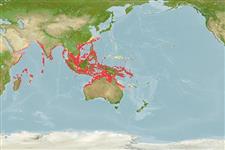>
Eupercaria/misc (Various families in series Eupercaria) >
Caesionidae (Fusiliers) > Gymnocaesioninae
Etymology: Dipterygonotus: Greek, di = two + Greek, pteryx = fin + Greek, gono, gone = birth + Greek, noton = back (Ref. 45335).
More on author: Valenciennes.
Environment: milieu / climate zone / depth range / distribution range
Ökologie
seewasser riff-verbunden; tiefenbereich 37 - 91 m (Ref. 26165). Tropical; 28°N - 24°S, 43°E - 163°E (Ref. 402)
Indo-Pacific: East Africa, not including the Red Sea or Arabian (Persian) Gulf, to the Solomon Islands.
Size / Gewicht / Alter
Maturity: Lm ? range ? - ? cm
Max length : 14.0 cm TL Männchen/unbestimmt; (Ref. 402)
Rückenflossenstacheln (insgesamt): 12 - 15; Rückenflossenweichstrahlen (insgesamt): 8-11; Afterflossenstacheln 3; Afterflossenweichstrahlen: 9 - 11.
Primarily a near-shore pelagic species (Ref. 30573), but swims mainly in open water away from reefs (Ref. 48636). Forms dense aggregations (Ref. 90102). Mixed with other planktivores and is easily overlooked. Feeds on zooplankton (Ref. 30573). Oviparous, with numerous, small pelagic eggs (Ref. 402). Caught at night using lights and dip nets (Ref. 30573). Important tuna bait fish in some countries (Ref. 30573).
Life cycle and mating behavior
Geschlechtsreife | Fortpflanzung | Ablaichen | Eier | Fecundity | Larven
Carpenter, K.E., 1987. Revision of the Indo-Pacific fish family Caesionidae (Lutjanoidea), with descriptions of five new species. Indo-Pac. Fish. (15):56 p. (Ref. 1723)
IUCN Rote Liste Status (Ref. 130435)
Bedrohung für Menschen
Harmless
Nutzung durch Menschen
Fischereien: weniger kommerziell; Köder: usually
Mehr Information
NamenSynonymeMetabolismusRäuberÖkotoxikologieFortpflanzungGeschlechtsreifeAblaichenSpawning aggregationFecundityEierEientwicklung
ReferenzenAquakulturAquakultur ProfilZuchtlinienGenetikElectrophoresesVererbbarkeitKrankheitenVerarbeitungNutrientsMass conversion
PartnerBilderStamps, Coins Misc.LauteCiguateraGeschwindigkeitSchwimmstilKiemenoberflächeOtolithsGehirngrößeSehfähigkeit
Tools
Zusatzinformationen
Download XML
Internet Quellen
Estimates based on models
Preferred temperature (Ref.
123201): 23.8 - 28.4, mean 27.4 °C (based on 421 cells).
Phylogenetic diversity index (Ref.
82804): PD
50 = 1.0000 [Uniqueness, from 0.5 = low to 2.0 = high].
Bayesian length-weight: a=0.01122 (0.00514 - 0.02450), b=3.04 (2.87 - 3.21), in cm total length, based on all LWR estimates for this body shape (Ref.
93245).
Trophic level (Ref.
69278): 3.4 ±0.45 se; based on food items.
Widerstandsfähigkeit (Ref.
120179): hoch, Verdopplung der Population dauert weniger als 15 Monate. (Preliminary K or Fecundity.).
Fishing Vulnerability (Ref.
59153): Low vulnerability (10 of 100).
Nutrients (Ref.
124155): Calcium = 109 [70, 193] mg/100g; Iron = 1.06 [0.67, 1.65] mg/100g; Protein = 18.8 [17.7, 19.8] %; Omega3 = 0.171 [0.105, 0.275] g/100g; Selenium = 36.7 [20.8, 68.2] μg/100g; VitaminA = 115 [46, 302] μg/100g; Zinc = 1.63 [1.14, 2.22] mg/100g (wet weight);
